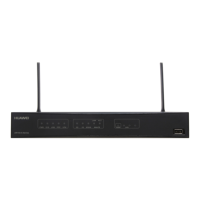Example
# Run the display arp interface command, and you can view ARP entries on Eth1/0/0.
<Huawei> display arp interface ethernet 1/0/0
IP ADDRESS MAC ADDRESS EXPIRE(M) TYPE INTERFACE VPN-INSTANCE
VLAN/CEVLAN PVC
------------------------------------------------------------------------------
192.168.1.11 0000-0a41-0201 I - Eth1/0/0 r1
192.168.1.1 0000-0a41-0200 15 D-6 Eth1/0/0 r1
------------------------------------------------------------------------------
Total:2 Dynamic:1 Static:0 Interface:1
# Run the display arp vpn-instance command, and you can view all the ARP entries in the
VPN instance r1.
<Huawei> display arp vpn-instance r1
IP ADDRESS MAC ADDRESS EXPIRE(M) TYPE INTERFACE VPN-INSTANCE
VLAN/CEVLAN PVC
------------------------------------------------------------------------------
10.10.20.9 0018-2000-0083 I - Vlanif888
10.10.10.6 0018-2000-0083 I - Vlanif833
------------------------------------------------------------------------------
Total:2 Dynamic:0 Static:0 Interface:2
# Run the display arp statistics command, and you can view the statistics on ARP entries.
<Huawei> display arp statistics all
Dynamic:1 Static:0
1.7 Configuring Inter-VLAN Proxy ARP
Inter-VLAN proxy ARP enables hosts in different sub-VLANs of a super-VLAN to
communicate with each other.
1.7.1 Establishing the Configuration Task
Before configuring inter-VLAN proxy ARP, familiarize yourself with the applicable
environment, complete the pre-configuration tasks, and obtain the data required for the
configuration. This will help you complete the configuration task quickly and accurately.
Applicable Environment
The VLAN aggregation technology isolates broadcast domain by using multiple VLANs on a
physical network so that different VLANs belong to the same subnet. This technology introduces
the super-VLAN and sub-VLAN. A super-VLAN contains one or more sub-VLANs in different
broadcast domains. A sub-VLAN does not occupy an independent subnet segment. In a super-
VLAN, IP addresses of hosts in different sub-VLANs are on the subnet segment corresponding
to the super-VLAN.
Sub-VLANs use the same Layer 3 interface to communicate. This reduces subnet IDs and subnet
default gateway addresses. The VLAN aggregation function allows different broadcast domains
to use the same subnet address, implements flexible addressing, and saves IP addresses.
Hosts in different sub-VLANs of a super-VLAN cannot communicate with each other. To enable
these hosts to communicate with each other, you can enable inter-VLAN proxy ARP on the sub-
interface or VLANIF interface corresponding to the super-VLAN.
Huawei AR150&200 Series Enterprise Routers
Configuration Guide - IP Service 1 ARP Configuration
Issue 02 (2012-03-30) Huawei Proprietary and Confidential
Copyright © Huawei Technologies Co., Ltd.
16

